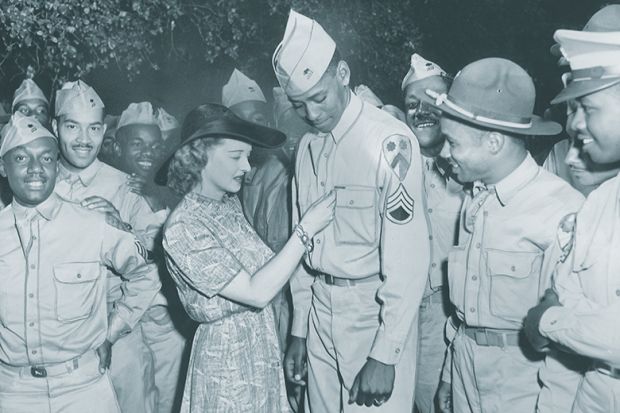Bette Davis made more than a hundred films in Hollywood between the early 1930s and the late 1980s. Initially, she struggled to impress the studio bosses, who dismissed her as a “little brown wren” lacking in sex appeal. But following a break afforded to her by British actor George Arliss, who spotted her unique talents, she began to carve a provocative and dramatic path through the studio system, involving lawsuits, suspensions, unforgettable classics and Academy Awards.
A recurrent feature of Davis’ films is her on-screen relationship with African American actors – veering from the sympathetic and understanding to the exploitative and murderous. It is perhaps surprising that the depiction of Black actors in Davis’ films has not received more attention in overviews of her career. Davis and fellow actor John Garfield opened the Hollywood Canteen in 1942, with the aim of providing movie stars to serve up food, drink and entertainment to American servicemen. As Julia A. Stern reports in Bette Davis Black and White, it was Davis who determined that the Canteen dance floor should not be segregated. She stated, famously, that “The Blacks got the same bullets as the whites did and should have the same treatment.”
Stern’s book is not an assessment of Davis’ own racism or anti-racism, which would, inevitably, involve airbrushing certain encounters and episodes in a 50-year career. As she makes clear in her introduction, her research has rather led her to assess the broader topic of mid-century American racial attitudes through the lens of Davis’ movies. Her approach is essentially twofold: she explores Davis’ affinities with African American actors, and she uses codes of race and class in a selection of her most interesting films to trace shifts in social and industrial attitudes across her career.
This perspective enables the uniqueness of Davis’ star image to emerge, especially in terms of her unconventional appearance and physical style, as well as her ambiguous and troubling characters. It also enables Stern to study the personal connection she has long felt with Davis: an actor who has always appealed to the outsider, the rebel, the Jezebel.
The encounters with racism are stark in many of Davis’ films, notably in the most dramatic of Stern’s case studies, In This Our Life (1942). This features a bold challenge to Hollywood stereotypes through a Black character called Parry (Ernest Anderson), a young man training to be a lawyer, whom Davis’ character frames for a killing she has caused. As an example of Davis’ fearlessness when it came to embodying white privilege, to the point of enacting the most callous racism, it serves to balance her more affectionate and sympathetic resonances with Black characters, her undoubted off-screen commitments to mentoring African American actors, and her refusal to accept inequality and unfairness in any of her endeavours. Not a hagiography or even a biography, this book instrumentalises the stardom of Bette Davis as a barometer of racism in a large section of 20th-century Hollywood.
Lucy Bolton is reader in film studies at Queen Mary University of London and the author of Contemporary Cinema and the Philosophy of Iris Murdoch (2019).
Bette Davis Black and White
By Julia A. Stern
University of Chicago Press, 248pp, £76.00 and £18.00
ISBN 9780226813691 and 9780226813868
Published 12 November 2021
Register to continue
Why register?
- Registration is free and only takes a moment
- Once registered, you can read 3 articles a month
- Sign up for our newsletter
Subscribe
Or subscribe for unlimited access to:
- Unlimited access to news, views, insights & reviews
- Digital editions
- Digital access to THE’s university and college rankings analysis
Already registered or a current subscriber? Login








